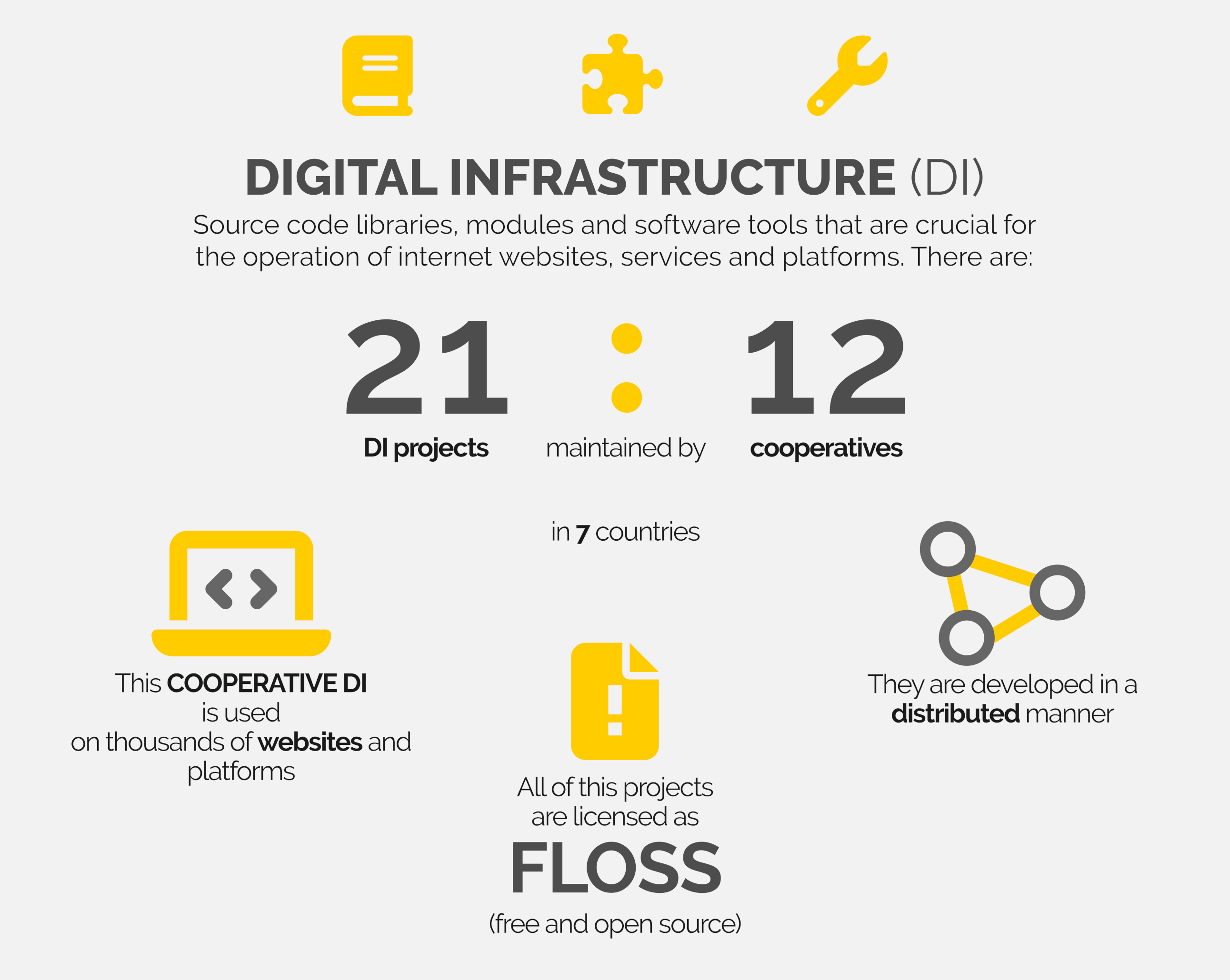We found 21 Digital Infrastructure (DI) projects developed and/or maintained by 12 cooperatives located in 7 countries: Argentina (3), Canada and India (1), Spain (1), USA (2), France (2) and England (3). The DI they develop and/or maintain is part of the Composer, Wordpress, Ruby, React, Redux, Vue, Symphony, Python, Django, Drupal and the Solid web standard ecosystems, and consists of: libraries, tools, frameworks, modules, an API, a protocol and time and billing management platforms, as well as a CMS distribution. All projects are licensed under FLOSS. The vast majority of these DI projects have been initiated by the cooperative, but not all. In the cases in which they have not started the project, they have supported the founders in its subsequent development and maintenance. The DI they develop is available in 5 open online repositories. All of these DI projects have contributors outside the cooperative forming a development community. This community is made up of freelance programmers, students, workers from other companies and independent consultants as well as different types and sizes of public and private organizations. In turn, those who use the DI are also companies and organizations of different types and sizes, as well as freelance workers, enthusiasts and students who benefit from it without necessarily requesting their service to the cooperatives.
Cooperatives that Develop DI

Cooperative Model to Develop DI

1. Value creation
The cooperative together with the development community creates DI generating value for its users:
- In a distributed way, the division of labor is extended among different people and groups that are in different locations and that they do not necessarily belong to the same organization.
- The exchange of knowledge facilitates participation. That is, the code, documentation, educational materials and development methods are shared.
- Knowledge is shared openly and therefore the results of the work are also shared.
2. Value proposition
The cooperative, due to its orientation to both the community and its participation in the market, adds to the value created:
- Diversity of skills that the development community doesn't have.
- Administrative planning and forecasting so that the DI is sustained over time.
- Workflows and community guidelines for contributions.
- Offers the result of the work added by the cooperative in the form of complementary products and services.
Due to its double orientation, the cooperative is specially equipped to make the digital infrastructure available to both users and clients.
3. Value capture
In exchange, the cooperative captures some of the value that is exchanged with the users and/or clients of the DI, selling and adding complementary services, without this capture being exclusive by the cooperative. This is because the DI is FLOSS licensed and this allows other members of the development community to make proposals and capture value.
Recommendations
Here are some suggestions obtained from the research findings and the model, intended for DI projects wishing to adopt the cooperative model:
-
Include people with management profiles in the cooperative that not only support with the administration of the co-op but also with the planning necessary to maintain the DI in the long term.
-
Members of the cooperative who specialize in communication are of great help in promoting the DI project and for attracting people with different abilities to the cooperative. They can also support making the documentation accessible and maintaining contact with the development community.
-
The democratic practices of a cooperative enterprise can be extended to the development community and include them in the decision making process about the direction of the DI project. This can be in the form of surveys, open discussion forums, polls, voting, etc.
-
The cooperative can contribute to the DI project with the procurement and maintenance of software development infrastructure such as hosting, domains and self-hosted repositories.
-
DI users are potential members of the development community. Responding to their requests can motivate them to join the development or request implementation and support services from the cooperative.
-
Intercooperation is one of the greatest strengths of the cooperative model. The cooperative should not only establish relationships of trust with the development community but also with other cooperatives that develop software, including consider joining federations.